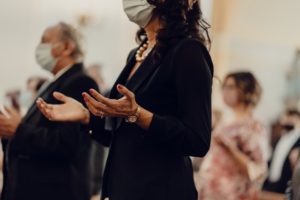
The coronavirus is horrifying, and sometimes it feels that congregations are not doing their best to meet the challenge. But there are signs that God is at work, helping us to learn and to transform ourselves.
In Kay Ryan’s poem “New Rooms” from her book Erratic Facts, she compares occupying an unfamiliar situation to tacking up an old room inside a new space “like an interior tent.” But “Oh,” she says, “the new holes aren’t where the windows went.”
I feel that “Oh…” It’s the frustration of every member who tries to adjust to Zoom or YouTube but can’t figure out how to mute themselves or make the Chat function work. It’s the despair of volunteers who normally visit a lonely older adult but now aren’t allowed inside the facility because of an outbreak. It’s the tears of colleagues who can’t gauge members’ reactions to their sermons, because now they preach on YouTube. We want desperately for this pandemic to be amenable to old ways of seeing and doing, but it’s not. We have to change.
What We Are Learning
The good news is that we can. The human and economic toll of the coronavirus is beyond calculation, but even so, congregations are learning:
- Now that we’ve been dragged online, we’re learning that people can now join us whose arthritis doesn’t ease until later in the day, or whose children are too active for our tastes, or who live in other states but like our style. We may be coming closer to the kind of crowd that gathered around Jesus than we ever did in a sanctuary!
- We’ve (mostly) made it to the other side of what may have been one of the fastest and most inclusive technological learning curves the church has ever seen! Hyperbole? perhaps—but for several weeks, one of my small congregations mailed DVDs of the worship service to an 80-something congregant. In the middle of the summer, she finally let me know we didn’t need to spend the money—she was watching the service live every week on her tablet!
- We’re learning that all kinds of meetings are not only easy to have online, they are remarkably well-attended! This may have to do with being desperate to see the faces of our friends, but it’s also true that, because of Zoom and other apps, we can “show up” for the congregation’s work in comfortable clothes while managing our children, caring for a sick spouse or partner, eating supper, or cuddling with our cats.
- Speaking of cats, because we now do the work of the congregation against a backdrop of living rooms, bookshelves, and vacation photos, we’re getting to know more about our fellow members. When we mostly met and talked in the church building, we rarely had a chance to get to know each other beyond cars and clothing preferences. Now most meetings start with conversations about visible artwork or pets.
Work and Worship in New Spaces
- We’ve discovered we can worship in what, to us, are truly astonishing places! Parking decks, parks, drive-ins—we’re worshipping anywhere the air is fresh and people can hear. If the challenges of a pandemic teach us nothing else, they will have demonstrated that ministers can, when necessary, give up their pulpits and stained glass in order to preach outside like Jesus.
- Paradoxically, not being able to worship in the building has led to a new appreciation for the building. We’ve had to think about the message that our building is communicating to its neighbors during a traumatic time. In my own congregation, we’ve planned additional Christmas trees for windows that usually were empty—because people driving by during Advent need to see light shining in the darkness.
- Our staff are learning they can operate remotely, and members finally are learning that it isn’t necessary for the staff to always be in the building. This is something ministers have long hoped to teach—that physical presence in the building is not necessary to and can even inhibit the work of ministry. Now that no one is in the building, we are learning that our work can happen anywhere.
Flexibility and Breaks
- We’re learning that our work can be flexible—sometimes happening from 9 to 5, but also after supper or at 5:00 AM. Ministers have always had this kind of schedule, too often without limiting their total work hours. In the future, however, allowing flexible work hours will be critical to congregations’ ability to attract and retain all kinds of staff as we accommodate the needs of parents with young children and others with complex lives.
- And we’re learning that ministers need to take breaks. We can’t work 24/7/365 and still have the compassion and creativity to adapt to challenges.
The coronavirus is horrifying, and the failure of states like my own to take even basic steps to control it is tragic. We will be mourning the unnecessary loss of lives for generations. In such dark times, it may feel that we and our congregations are not keeping up. But even though “the new holes aren’t where the windows went,” God is still with us as we become something new.
Sarai Rice is a Presbyterian minister and a retired non-profit executive. She consults with congregations on a variety of issues, including planning, staffing, and governance. Sarai loves to work with congregations that are exploring anew their role in the community as well as congregations seeking new energy in the face of decline. She has a deep commitment to the notion that human institutions should work well for the people they serve.
